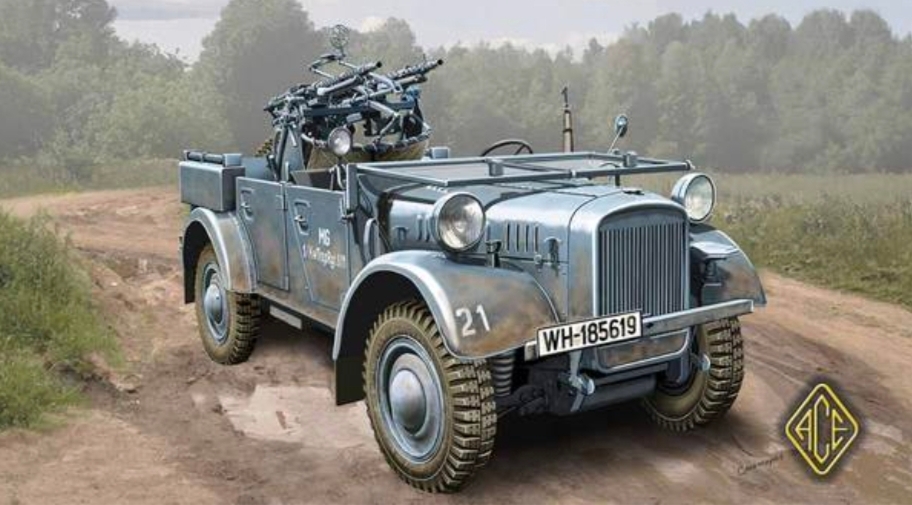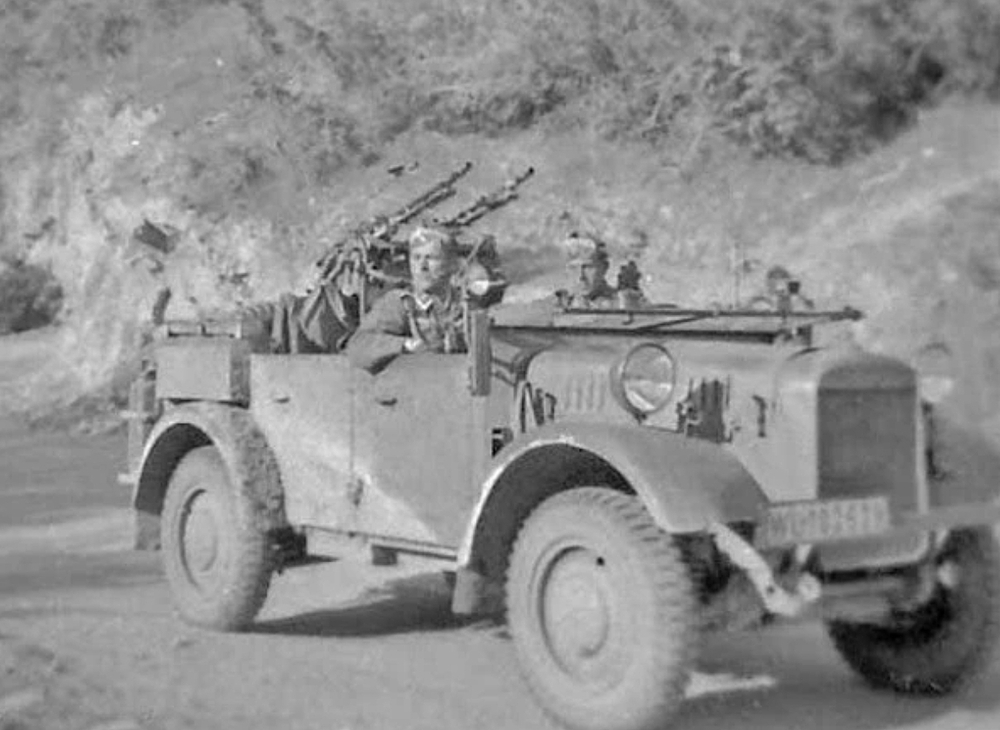

HISTORY
The Kfz 4 is an anti-aircraft light modification of the le.gl.Einheitz-PKW and was officially introduced at the end of February 1938.
The modification le.gl.Einheitz-PKW Kfz.4 was equipped with the Zwillingssockel 36 anti-aircraft mount and was used to destroy enemy airborne troops. The vehicle was simple and technologically easy to produce, featuring an open all-metal three- or four-door body (in the Kfz 2 and Kfz 4 versions the right rear door was missing, with an external fuel canister attached to the body in its place), a foldable canvas top, and removable doors.[u]
The vehicle entered service in 1938. Its movement was most often powered by a 4-cylinder Stöewer engine with a displacement of 2 liters and an output of 50 hp. The vehicle was about 3.9 meters long with a wheelbase of 2.4 meters. Armament consisted of two twin-mounted MG34 machine guns. The Kfz.4 was designed and produced by “Stöewer”, but later “BMW” and “Hanomag” also began licensed production.
The design of the vehicle was largely based on the Kfz 1 and Kfz 3 cars. For example, all three vehicles had almost identical bodies. The Kfz 4 was intended to provide immediate short-range and very short-range air defense for German motorized and mechanized units. Its armament was mounted on a rotating carriage (German: Zwilingslafette 36).
SPECIFICATIONS
Crew: 4 men
Length: 3.9 m
Width: 1.95 m
Height: 2 m (with mounted machine gun)
Weight: 2,100 kg (with weapons and crew)
Power: 50–60 hp
Drive: 4x4 (all-wheel drive)
Maximum speed: 70 km/h
Armament: 2 twin-mounted MG-34 (or MG-42)
INTERESTING FACTS
-
Limited production
— Only about 1,100 units of the Kfz.4 were produced, which makes the vehicle rare even among Wehrmacht equipment. -
First specialized German anti-aircraft vehicle
— Before the Kfz.4, anti-aircraft machine guns were usually mounted directly on trucks or tripods. The Kfz.4 became the Wehrmacht’s first attempt at creating a “standard” mobile AA unit on a light car. -
More often used against infantry than against aircraft
— Although the Kfz.4 was designed as an AA vehicle, in practice it was often used to provide fire support for infantry. The twin-mounted MG-34 was an excellent “reaper” against enemy manpower. -
Transitional vehicle
— The Kfz.4 turned out to be a “trial version”: it quickly became clear that machine guns were not enough against aircraft, and it was soon replaced by vehicles armed with 20 mm FlaK 30/38 cannons (for example, the Sd.Kfz.10/4). -
Rarity in museums
— Very few original Kfz.4s have survived to this day, unlike the more common Opel Blitz or Kübelwagen. Models and replicas are far more likely to be found (for example, in 1:35 scale). -
Standardized chassis
— The Kfz.4 was produced on the basis of the Einheits-PKW (“standardized all-wheel-drive vehicle”), which was manufactured by several companies: Stoewer, BMW, and Hanomag. This was part of the Wehrmacht’s standardization program.
This little vehicle could be sent to BR 1 because it is very vulnerable, but it could destroy all enemy aircraft of this BR and even BR 2.
Thank you for your attention!!!
